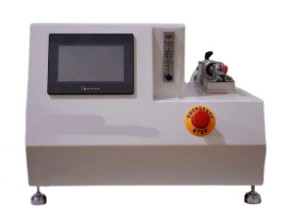The mask pressure difference tester, also known as the mask air permeability tester, is a tool to determine the air permeability of medical mask materials.
The mask differential pressure tester is an instrument used to test the air permeability (pressure difference) of medical masks. It uses a suction air source as the power source of the instrument, and is not limited by the space of the test site. It is equipped with a precision differential pressure sensor and two digital display samples. Side pressure difference, special sample clamp to ensure a firm grip of the sample. Install the mask sample on the channel (fixture) with a fixed cross-sectional area, start the vacuum pump, and the airflow at a specific flow rate will generate a certain pressure difference on the upper and lower sides of the test sample, so as to calculate the breathability of the mask. The tester has built-in precision air pump, flow sensor, differential pressure sensor, single-chip control, precise control of flow rate and differential pressure measurement. The tester has a high-resolution differential pressure sensor with a digital display to display the results. The air pump can simulate artificial respiration, and the flow sensor and differential pressure sensor can be used to collect test data and pressure, and reflect it into the computer software.

The operation method of the mask differential pressure tester is as follows:
1. Power-on preparation: Power on the instrument to preheat in a standard test environment, and the preheating time is at least 30 minutes. If the warm-up time is less than 30 minutes, it will affect the test results
2. Sample preparation: Take a certain amount of samples to be tested, and the number should generally not be less than 5. Check the sample, the sample should be free of obvious defects.
3. Preparation before the test: connect the gas source, and the pressure of the gas source is not less than 0.6MPa.
4. Carry out the test: set the test and test flow, place the sample, start the test, and end the test, the system will automatically determine the test result and display qualified/unqualified.
5. Carry out the next set of sample tests: if you need to continue the test, repeat the above experimental steps.
6. End of test: After the test is over, return to the main page. Turn off the power and air supply on the device, and cover it with a dust cloth. The dust cloth should be kept neat and clean without dust.
Prev: How to correctly select textile testing instruments?
Next: Key Points for Selecting and Using Textile Testing Instruments